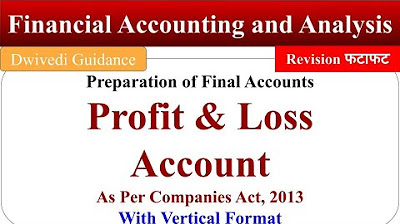Financial Accounting 1: 13- Sections Of A Classified Statement Of Financial Position (شرح بالعربي)
Summary
TLDRThis video provides an in-depth explanation of financial statements and classifications, focusing on the balance sheet. It covers key topics such as current assets, liabilities, and equity, with a breakdown of levels from short-term to long-term investments and obligations. The presenter discusses examples like cash flow, inventory, loans, and intangible assets, emphasizing the importance of organizing financial items by liquidity and maturity. The video aims to clarify how companies structure and present their financial data, ensuring a clear understanding of the overall financial position.
Takeaways
- 📊 The video discusses the structure of classified financial statements, particularly the balance sheet and how accounts are presented at a specific point in time.
- 🏦 Financial statements are prepared annually but can also be created at the end of each month to track financial positions over time.
- 🔄 Assets and liabilities are categorized by their similarities, such as current assets, long-term investments, and intangibles, to create a clear financial picture.
- 💰 Current assets include cash and other accounts that can be converted into cash within a year, like accounts receivable and short-term investments.
- 🏢 Long-term investments refer to assets held for more than a year, such as stocks and real estate, not used in daily operations.
- 📈 Intangible assets include non-physical assets like patents, trademarks, and goodwill, which are categorized under intangible assets on the balance sheet.
- 💼 Current liabilities are obligations that a company expects to settle within a year, such as accounts payable and short-term loans.
- 📅 Long-term liabilities are debts expected to be paid over a period longer than one year, such as mortgage loans and bonds payable.
- 🔄 The order of liquidity is used to arrange assets from least liquid (harder to convert to cash) to most liquid, with cash usually listed last.
- 📝 Owner's equity includes the capital invested by the owners and retained earnings, reflecting the net worth of the business after liabilities are subtracted.
Q & A
What is meant by the term 'classified' in the context of the video?
-The term 'classified' refers to the classification of financial statements, such as the classification of assets, liabilities, and equity into different levels for better organization and understanding of the financial position.
What is a financial position statement and when is it typically prepared?
-A financial position statement, also known as a balance sheet, provides a snapshot of a company’s assets, liabilities, and equity at a specific moment in time. It is typically prepared at the end of the year but can also be done at the end of each month.
What are the different levels of classification in the financial statements?
-The financial statements are classified into three levels: Level 1 includes broad categories such as current assets and liabilities, Level 2 breaks down these categories further (e.g., bank accounts or long-term investments), and Level 3 details specific items within each category.
What is the difference between current assets and long-term assets?
-Current assets are short-term assets that are expected to be converted into cash within a year, such as cash, accounts receivable, and inventory. Long-term assets include items like property, equipment, and long-term investments, which are held for more than one year.
How are intangible assets categorized in financial statements?
-Intangible assets, such as patents, trademarks, goodwill, and copyrights, are classified as non-physical assets that provide value to a company but are not tangible. These are placed under 'intangible assets' in the financial statements.
What are examples of current liabilities mentioned in the video?
-Current liabilities include obligations that are expected to be settled within a year, such as notes payable, accounts payable, accrued expenses, and short-term loans.
What is meant by 'long-term liabilities'?
-Long-term liabilities are financial obligations that a company expects to settle over a period longer than one year, such as mortgage loans, bonds payable, and long-term leases.
How are investments in other companies classified?
-Investments in other companies, such as stocks or bonds, that are not part of the company's core operations are categorized as long-term investments under the non-current assets section of the balance sheet.
What is the significance of the 'order of liquidity' in financial statements?
-The order of liquidity refers to the arrangement of assets in a balance sheet based on how easily they can be converted into cash. Items like cash are placed first as they are most liquid, while assets like inventory or property are placed later.
What is the purpose of presenting financial information in a classified format?
-The purpose of presenting financial information in a classified format is to organize assets, liabilities, and equity into categories and subcategories, providing clarity for users to better understand the financial health and structure of the company.
Outlines

Esta sección está disponible solo para usuarios con suscripción. Por favor, mejora tu plan para acceder a esta parte.
Mejorar ahoraMindmap

Esta sección está disponible solo para usuarios con suscripción. Por favor, mejora tu plan para acceder a esta parte.
Mejorar ahoraKeywords

Esta sección está disponible solo para usuarios con suscripción. Por favor, mejora tu plan para acceder a esta parte.
Mejorar ahoraHighlights

Esta sección está disponible solo para usuarios con suscripción. Por favor, mejora tu plan para acceder a esta parte.
Mejorar ahoraTranscripts

Esta sección está disponible solo para usuarios con suscripción. Por favor, mejora tu plan para acceder a esta parte.
Mejorar ahoraVer Más Videos Relacionados

5. Understanding balance sheet

BAB 4 Aktivitas Berbasis Riset Pencatatan Laporan Keuangan (Penilaian SMK - Akuntansi 11)

final accounts introduction in telugu part 1 #RSACADEMY|#degree #accountancy #finalaccounts #inter

The KEY to Understanding Financial Statements

Noções de Contabilidade - Aula 5.1

Profit & Loss Account, Preparation of Final Accounts, Format of Profit and Loss Account, Accounting
5.0 / 5 (0 votes)
